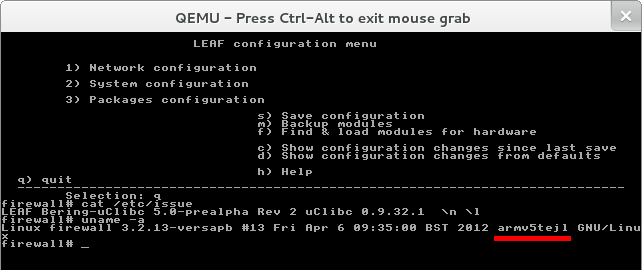Difference between revisions of "Bering-uClibc 6.x"
From bering-uClibc
m (→Development History) |
m (→Main Features) |
||
| Line 5: | Line 5: | ||
The key characteristics of [[Bering-uClibc 6.x]] are: | The key characteristics of [[Bering-uClibc 6.x]] are: | ||
* Based on a recent long-term release of the Linux Kernel. | * Based on a recent long-term release of the Linux Kernel. | ||
| + | * Easy-of-use | ||
| + | ** Hardware detection during boot, necessary modules enabling the hardware will be loaded automatically. | ||
| + | ** Load modules when needed for various Packages - e.g. netfilter modules for <code class="filename">shorewall[6]</code>. | ||
| + | ** Check for and receive updates with command line utility (<code class="filename">upgrade</code>) or Web GUI (<code class="filename">webconf</code>) from the Packages repository. (This feature has been introduced in the late 5.2 cycle for testing.) | ||
* Targeted to run on industry standard devices even with non-x86 processors.[[Image:Bering-uClibc_5.0-prealpha_armv5.png|center|frame|alt=QEMU ARM Screenshot|Bering-uClibc 5.0-prealpha running on an emulated ARM processor]] | * Targeted to run on industry standard devices even with non-x86 processors.[[Image:Bering-uClibc_5.0-prealpha_armv5.png|center|frame|alt=QEMU ARM Screenshot|Bering-uClibc 5.0-prealpha running on an emulated ARM processor]] | ||
* Designed to perform well on relatively low-specification hardware. In particular: | * Designed to perform well on relatively low-specification hardware. In particular: | ||
Revision as of 16:02, 1 May 2016
Contents
Overview
Bering-uClibc is one of the branches of the LEAF (Linux Embedded Appliance Framework) project, delivering on LEAF's ambition to provide a secure, feature-rich, customizable embedded Linux network appliance for use in a variety of network topologies. Although it can be used in other ways, its primary goal is as a Internet gateway, BRAS, router, firewall and wireless access point.
Main Features
The key characteristics of Bering-uClibc 6.x are:
- Based on a recent long-term release of the Linux Kernel.
- Easy-of-use
- Hardware detection during boot, necessary modules enabling the hardware will be loaded automatically.
- Load modules when needed for various Packages - e.g. netfilter modules for
shorewall[6]. - Check for and receive updates with command line utility (
upgrade) or Web GUI (webconf) from the Packages repository. (This feature has been introduced in the late 5.2 cycle for testing.)
- Targeted to run on industry standard devices even with non-x86 processors.
- Designed to perform well on relatively low-specification hardware. In particular:
- The system runs from an in-memory filesystem. Disk storage is only required for booting and for storing configuration settings.
- The uClibc-ng C library is used in place of the GNU C Library since uClibc-ng is much smaller in size.
- Considerable use is made of BusyBox utilities as replacements for larger applications.
- Focussed on providing excellent networking facilities.
- Designed to have high fault tolerance:
- There are no writes on HDD/flash during work (except saving configurations during maintenance) - so a power failure will not break file system.
- Corrupted/erased config file, or even 'rm -rf /' isn't a problem - changes are stored permanently only when user requires that, and reboot will restore all as it was before.
- Enabled by default watchdog, reboot on kernel panic and kernel soft-lockup detection will help to have minimum downtime of router.
- Backup scripts will help to restore system state on storage failure/operator mistake.
Development History
Bering-uClibc 6.x is basically Bering-uClibc 5.x brought up to date with the latest versions of the main software components and with reworked toolchain. Bering-uClibc 6.0 provides in particular:
- gcc update to 5.3.0.
- The Linux kernel has been upgraded to 4.4.x.
- The uClibc library is upgraded from uClibc 0.9.32 to uClibc-ng 1.0.x.
Version Changelog
Known Issues
Further Documentation
For further information see:
- Bering-uClibc 6.x - Developer Guide for Developers of new features or new application Packages.
